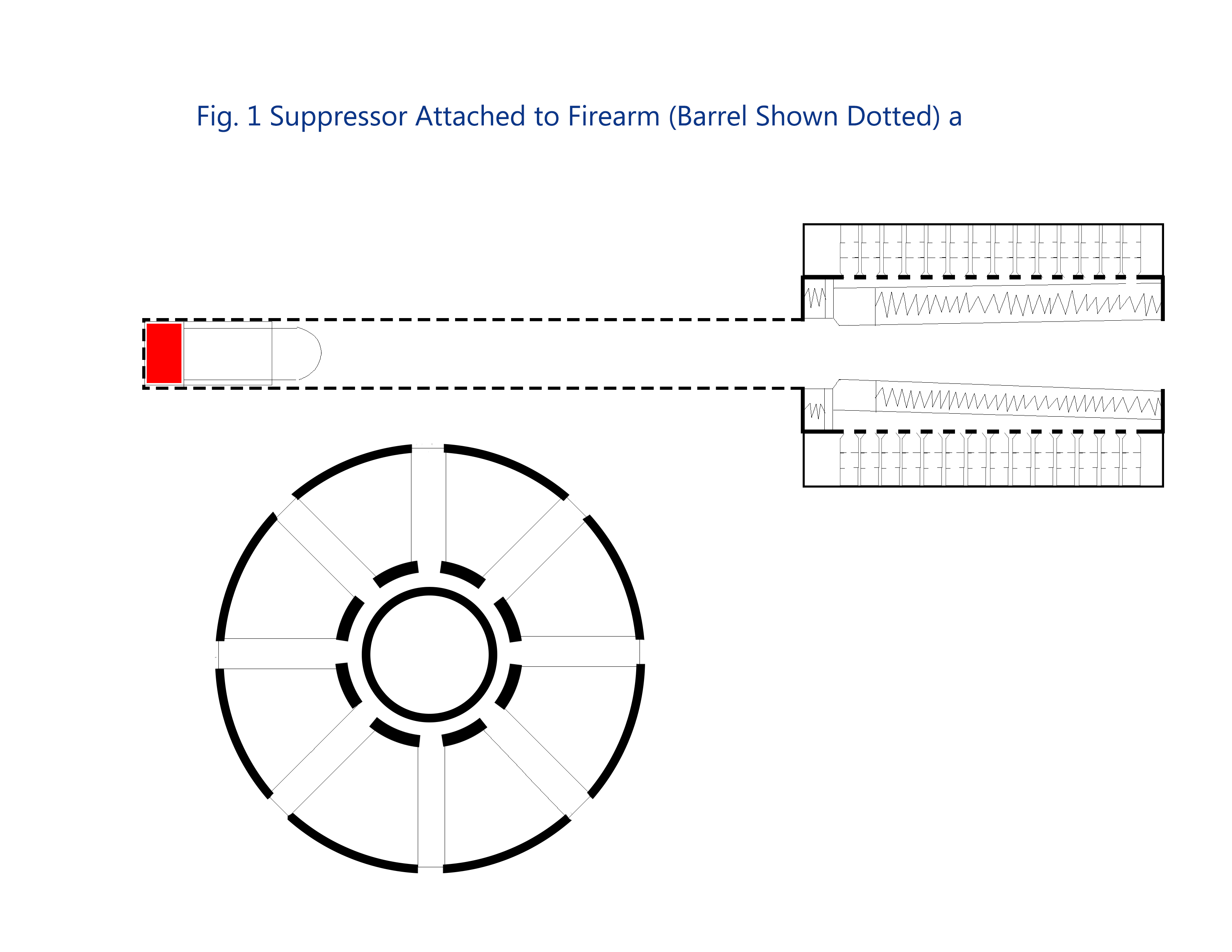Partially-Arrested Sabot Firearm Suppressor

- Concept Original Year: 2015
- Market Viability: Yellow
- Est. Prototype Cost: $1000
- Est. Production Unit Cost: $200
I envisioned this after reading reports of realtime sound-triangluation devices being used by US Forces to pinpoint hostile insurgents in the urban environments of then contemporary conflicts. Placing this technology in the context of a near-peer conflict, this technique allows the production of firearms of arbitrary bore capable of operating with virtually zero muzzle report, creating sound waves only downrange in the case of supersonic rounds.
I obtained a provisional patent in 2015, which expired in 2016 after I was unable to obtain an audience to pitch the concept to any of several manufacturers.
Some years later, I found a similar concept published about an experimental Russian rifle; researching this led me to discover the history of captive piston design and the work of Igor Stechkin. This concept is similar, but relies on discarding a sabot at relatively low velocity, rather than a fully-arrested captive piston. To my knowledge, to date, nothing like this is available for manufacture in the West.
Suspension Frame Housing
- Concept Original Year: 2020
- Market Viability: Green
- Est. Prototype Cost: $75,000
- Est. Production Unit Cost: $75,000
The result of an attempt to design the most cost-efficient zero-lumber residential structure. After researching the rich history of this problem, I came up with a design based around using vertical steel beams driven into the ground as the primary load-bearing structure. From this, cables can be run to the ground or superstructures, like a circus tent, and drywall hung, along with a floating foundation.
This type of structure could be constructed quickly and has the added advantage of avoiding the foundation problems that plague traditional residential homes. In extreme cases, the foundation can even be left floating with considerable clearance over the ground (i.e. in high-flood areas) or built over rocky or uneven ground.
Iron Disulfide Photovolatic Cells
- Concept Original Year: 2021
- Market Viability: Red
- Est. Prototype Cost: Unknown
- Est. Production Unit Cost: $100
Mineral Iron disulfide, aka pyrite/fools gold, has seen considerable investigation over the last ~20 years or so to its suitability as a semiconducting material in PV cells, largely due to its theoretical band gap of 0.95 eV. The primary deficit in its suitability stems from a very low open-circuit voltage. A 2020 review of the literature by Mohammad Rahman, Gerrit Boschloo, Anders Hagfeldt, Tomas Edvinsson stated:
“Since its first demonstration,[6] despite this high recognition and an intermittent research efforts of over three decades, however, FeS2 solar cells never have exceeded a PCE greater than 2.8%. This value was attained in a photoelectrochemical cell with a liquid junction I−/I3− electrolyte and any PCE has not yet been certified in an accredited laboratory, while solid‐state devices so far show significantly lower PCE. The low PCE is mainly due to the extremely poor open‐circuit voltage, VOC (typically <200 mV).[1, 7] Secondary phases, surface conduction phenomena, and undesired doping have been reported as the key issues behind this poor conversion efficiency[7-13] that subsequently lead to phenomena, such as surface inversion,[7] ionization of deep donor states,[10] and photocarrier recombination[14] for loss of photovoltage.”
My idea is to apply the technique developed by William Regan, Steven Byrnes, Will Gannett, Onur Ergen, Oscar Vazquez-Mena, Feng Wang, and Alex Zettl at Berkely as discussed in their 2012 paper Screening-Engineered Field-Effect Solar Cells to mitigate this material deficit.
I rate the market viability of this concept as red due to the current state of investment and research into silicon-based PV cells, which has not only produced increasingly cost-effective designs, but created considerable moat in the industry around silicon-based PV cells.
Close Range RF Phase Difference Motion Tracking
- Concept Original Year: 2021
- Market Viability: Green
- Est. Prototype Cost: $35,000
- Est. Production Unit Cost: $400
Non-Fungible Tokens for Non-Profit Fundraising
- Concept Original Year: 2022
- Market Viability: Red
- Est. Prototype Cost: $10,000
- Est. Production Unit Cost: $100
This concept became the Side Project Space City Pups
Applying FinTech Economic Models to Space Commerce
- Concept Original Year: 2023
- Market Viability: Green
- Est. Prototype Cost: N/A
- Est. Production Unit Cost: N/A
by Daniel J. Prejean and Jason Ruszkowski
Live-Stream Production Lifetime Consumer Goods
- Concept Original Year: 2023
- Market Viability: Yellow
- Est. Prototype Cost: $50,000
- Est. Production Unit Cost: $10,000
Small Batch Basic Oxygen Steelmaking
- Concept Original Year: 2024
- Market Viability: Yellow
- Est. Prototype Cost: $10,000
- Est. Production Unit Cost: $5,000
Linear Power Supply
- Concept Original Year: 2025
- Market Viability: Yellow
- Est. Prototype Cost: $500
- Est. Production Unit Cost: $300
Ethics/Values/Intention Model of Economics
- Concept Original Year: 2025
- Market Viability: N/A